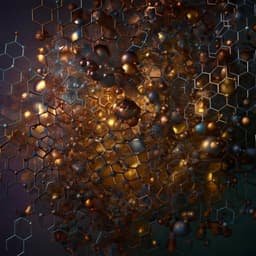
Physics
Nanoscale visualization and spectral fingerprints of the charge order in ScV<sub>6</sub>Sn<sub>6</sub> distinct from other kagome metals
S. Cheng, Z. Ren, et al.
Dive into the fascinating world of charge density waves in kagome metals! This groundbreaking research by a team of experts explores the unique charge order in ScV6Sn6, uncovering distinct behaviors that set it apart from other kagome metals. Join the journey to understand the fundamental differences revealed through advanced spectroscopic techniques.
~3 min • Beginner • English
Introduction
The kagome lattice hosts Dirac fermions, flat bands, and Van Hove singularities, enabling diverse correlated and topological phenomena. In several kagome metal families (Fe-, Mn-, Co-based magnets and AV3Sb5), charge density waves (CDWs), superconductivity, and symmetry-breaking states have been reported. The RV6Sn6 (166) kagome family offers tunable magnetism via rare earth substitution with nonmagnetic V kagome layers. ScV6Sn6 uniquely exhibits a three-dimensional charge order (CO) below TCO ≈ 92 K with wavevector Q* = (1/3, 1/3, 1/3), rotated 30° relative to the hexagonal lattice and connecting K points (Dirac nodes), unlike AV3Sb5 where CDW vectors connect M (VHS) points. Reports of time-reversal symmetry breaking and anomalous Hall effect concomitant with CO raise questions about its origin. This study investigates whether the CO arises from Fermi-surface nesting (particularly VHSs), whether rotational symmetry is broken, and what spectroscopic fingerprints (gaps, modulations) accompany the CO in ScV6Sn6.
Literature Review
Prior work on kagome metals established Dirac/Weyl fermions, flat bands, and correlated states in Fe-, Mn-, and Co-based systems, and CDW/superconductivity in AV3Sb5 with potential loop-current order. In AV3Sb5 and FeGe, 2×2 CDWs relate to nesting between VHSs at M and exhibit rotational symmetry breaking (C6 to C2) and CDW gap signatures near EF in STM/ARPES. In the RV6Sn6 (166) family, V layers are nonmagnetic and magnetism is tuned by R; ScV6Sn6 uniquely shows a 3D CO with Q*=(1/3,1/3,1/3). Muon spectroscopy and transport reported time-reversal symmetry breaking and anomalous Hall signals at TCO in ScV6Sn6. DFT and diffraction indicate modest atomic displacements at V and Sn2 layers but abundant lattice instabilities and phonon softening, including at K. Theoretical studies suggest Dirac node placement near EF and electron-phonon coupling can stabilize √3×√3 CDW order on kagome lattices.
Methodology
- Crystal growth and characterization: ScV6Sn6 single crystals grown by Sn-flux (Sc:V:Sn=1:6:40), heated to 1125 °C, cooled to 780 °C at 2 °C/hr, then decanted. Magnetization measured (ZFC, 1 T in ab-plane) to identify CO transition near 92 K.
- STM/STS: Samples cleaved in UHV and measured at ~4.5 K with etched W tips on a custom Unisoku USM1300. Topographs and spectroscopic dI/dV(r,V) maps acquired via lock-in (≈910 Hz). Surface terminations identified by atomic lattice signatures (Sn2 hexagonal lattice vs kagome layer). Fourier transforms (FTs) of topographs and dI/dV maps used to detect superlattice peaks at Q* along Γ–K. Energy-dependent FT linecuts along the three Γ–K directions probed dispersion/constancy of CO peaks. Step-edge phase analyses tested 3D CO nature. Average and spatially resolved dI/dV spectra quantified partial gap magnitudes. Bias-dependent dI/dV(r,V) and topographs at opposite polarities assessed contrast inversion energies.
- ARPES: ScV6Sn6 measured at CLS QMSC (R4000 analyzer); TbV6Sn6 at SSRL 5-2 (DA30 analyzer). In-situ cleaves at 20 K; base pressure <6×10^-11 Torr; energy/angular resolution better than 20 meV/0.1°. Fermi surface maps and dispersions along Γ–K–M acquired with LH/LV polarizations. Temperature-dependent cuts across K (20–120 K) analyzed via difference maps against 120 K, EDCs, and integrated spectral weight between −0.2 eV and EF to track reconstruction across T*.
- DFT: For ScV6Sn6, VASP with PBE-GGA, plane-wave cutoff 300 eV, force convergence 1 meV/Å, k-mesh 21×21×10. Surface states modeled with 8-kagome-layer slabs. Spin-orbit coupling not included. CDW state modeled with 3D wavevector (1/3,1/3,1/3); band unfolding to pristine BZ. For TbV6Sn6, FP-LAPW (WIEN2k), PBE-GGA; Tb 4f treated as open-core; RMT×Kmax=8.0; SOC included; convergence to Δcharge<1e-3 e, ΔE<0.01 mRy with 264 IBZ k-points.
Key Findings
- Real-space CO: STM reveals a √3×√3 R30° superstructure on the kagome termination with six superlattice FT peaks at Q*=(QBragg+QBragg)/3 along Γ–K, matching the in-plane component of the bulk CO wavevector (1/3,1/3,1/3). Phase shift across step edges confirms 3D character.
- Termination dependence: CO modulations and spectroscopic signatures are strong on the kagome termination but absent on the Sn2 termination near EF. Correspondingly, a partial density-of-states gap is observed only on the kagome surface.
- Partial gap magnitude: dI/dV spectra on the kagome termination show a partial gap ΔCO ≈ 20 meV at EF; no such gap on Sn2.
- Momentum-space comparison: ScV6Sn6 and TbV6Sn6 share very similar fermiology and dispersions (VHS at M near EF; in Sc slightly below, in Tb slightly above), arguing against a VHS (M-point) nesting origin for CO in ScV6Sn6.
- Temperature-dependent ARPES: Substantial spectral weight change near K appears below T*≈92 K, with weight shifted toward EF on the K-to-M side; integrated EDC weight between −0.2 eV and EF drops abruptly across T*, consistent with a first-order transition window ~15 K.
- DFT interpretation: Bulk CDW folding yields little change at K due to lack of bulk states near H. Surface-state calculations under CDW folding predict band folding and gap openings near K with upper branch pushed toward EF, consistent with observed ARPES spectral weight shifts.
- Symmetry: Unlike AV3Sb5, ScV6Sn6 shows no rotational symmetry breaking; CO amplitudes along the three Γ–K directions are nearly identical across energy, and dI/dV maps lack unidirectionality.
- Contrast inversion: STM reveals CO contrast inversion between −200 mV and +200 mV, but unusually the inversion near EF is absent; instead inversion occurs at positive energies ~60–80 mV. No inversion is observed between −40 mV and +40 mV, despite the small 20 meV gap at EF.
- Implication: The unusual positive-energy inversion suggests an additional spectral gap away from EF, possibly associated with a Dirac cone at K implicated in stabilizing √3×√3 CO, rather than VHS nesting at M.
Discussion
The combined STM/STS and ARPES results demonstrate that CO in ScV6Sn6 is fundamentally distinct from CDWs in other kagome metals like AV3Sb5 and FeGe. Despite similar fermiology and VHS proximity to EF, ScV6Sn6 exhibits a CO wavevector that connects K points rather than M points, and lacks in-plane rotational symmetry breaking. The small partial gap at EF (~20 meV) and the termination-specific manifestation of CO indicate layer-dependent charge modulation rather than large lattice displacements. Temperature-dependent ARPES implicates states near K, with spectral weight shifting toward EF below T*, consistent with surface-state folding and gap opening predicted by DFT under the bulk CDW wavevector. The unexpected contrast inversion occurring at positive energies (~60–80 mV), not at EF, points to multiple spectral gaps; since its energy scale is incompatible with the large DFT-predicted bulk gap at negative energies and the small EF gap, the inversion likely reflects a gap opening in Dirac-like states near K. This supports a mechanism in which Dirac node placement and phonon softening at K, together with electron-phonon coupling, drive the √3×√3 CO in ScV6Sn6, rather than VHS nesting at M. These insights revise the paradigm for CO formation in kagome systems and provide guidance for identifying similar orders in materials with Dirac features at K and structural instabilities.
Conclusion
This work provides nanoscale visualization and comprehensive spectroscopic evidence of charge order in ScV6Sn6. Key contributions include: (1) direct imaging of a √3×√3 R30° CO consistent with a 3D bulk wavevector (1/3,1/3,1/3); (2) identification of a small partial gap at EF (~20 meV) and strong termination dependence (present on kagome, absent on Sn2); (3) absence of rotational symmetry breaking, in contrast to AV3Sb5; (4) momentum-space evidence of band reconstruction near K below T* consistent with surface-state folding in DFT; and (5) discovery of an unusual positive-energy contrast inversion (~60–80 mV), implying multiple spectral gaps and pointing to a Dirac-cone-related CO mechanism. Together, these results argue against a VHS-nesting-driven CO and instead support a scenario involving Dirac nodes at K and phonon softening. Future directions include high-resolution probes of the Dirac cone gap at K (e.g., low-temperature ARPES with higher energy resolution), inclusion of spin-orbit coupling and many-body effects in theory, layer-resolved measurements to clarify termination dependence, and systematic rare-earth substitution or pressure tuning to test the Dirac/phonon-driven CO mechanism.
Limitations
- Energy resolution (ARPES ~20 meV) and surface sensitivity may limit direct observation of small gaps at K; inferred reconstructions rely on spectral weight shifts and DFT comparisons.
- Spin-orbit coupling was not included in ScV6Sn6 DFT slab and bulk calculations, which may affect fine details of band splitting and gap magnitudes.
- The precise origin of the positive-energy contrast inversion is hypothesized (Dirac-cone-related) but not directly resolved in dI/dV spectra; multiple gaps complicate unambiguous assignment.
- Strong termination dependence suggests surface-specific effects; bulk vs surface contributions to the observed spectroscopic features may be challenging to fully disentangle.
- Quantitative atomic displacement patterns associated with CO were not directly measured here and are taken from prior diffraction/DFT works.
Related Publications
Explore these studies to deepen your understanding of the subject.







